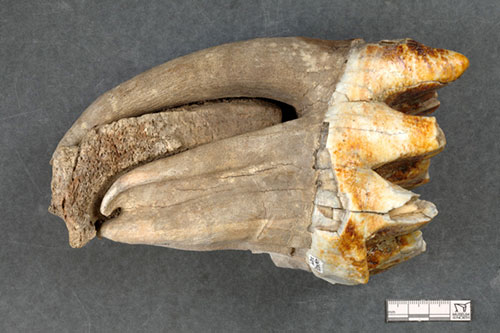
New dates for northern mastodon fossils resolve quandaryBy THERESA BAKKER
January 14, 2015
In a recent publication of the Proceedings of the National Academy of Sciences, an international team of researchers, including University of Alaska Fairbanks faculty members Patrick Druckenmiller, Pam Groves and Dan Mann, report that northern mastodon fossils are much older than previously thought. The new dates better match what what paleontologists know about changes in the mastodons’ habitat during the Ice Age.
This mastodon tooth is in the earth sciences collection at the University of Alaska Museum of the North. It was used in a recent study revising the age of mastodons published in the Proceedings of the National Academy of Sciences.
The team of scientists, led by Yukon Palaeontology Program paleontologist Grant Zazula, set out to re-date mastodon fossils from Alaska and the Yukon using new and more accurate techniques in radiocarbon dating. “It turns out that some of the previous dates were inaccurate and underestimated the actual time mastodons lived in these areas,” Druckenmiller said. “This means mastodons were only temporary inhabitants of what became Alaska and the Yukon during warm spells of the last Ice Age. “They did not live in Alaska during full glacial periods between 75,000 and 10,000 years ago.” Mann said new dating techniques used by Zazula revealed that the younger mastodon ages were contaminated by tiny amounts of fresher carbon, probably coming from plant rootlets and bacteria that penetrated bones in search of nutrients. This young carbon cause the radiocarbon ages obtained by older laboratory techniques to be more recent than the true ages of the animals. “From their tooth anatomy, we knew these animals were eating woody vegetation,” Mann said. “We figured that maybe they were living in willow thickets along rivers.” The new dates show convincingly that all of the mastodons in Alaska and the Yukon are older than the limits of radiocarbon dating. They most likely lived during the last interglacial period around 120,000 years ago, when the climate was warm and there was abundant mastodon “chow” available both north and south of the Brooks Range. The new report also suggests that humans would not have been involved in the extermination of mastodons in the Arctic and sub-Arctic, since the animals died out in these areas before humans crossed over the Bering Isthmus from Asia into North America. Mastodons disappeared from Alaska and Yukon several tens of millennia before the onset of major climatic changes at the end of the last Ice Age 10,000 years ago. However, mastodons did survive south of the continental ice sheets that covered much of North America until about 10,000 years ago, when they were among 70 species of Ice Age mammals to disappear from North America. Curator Druckenmiller said the UA Museum of the North has a major collection of mastodons from Beringia, a vast area that includes part of Northeastern Russia and east across Alaska to the Yukon. Fifteen of the 36 specimens re-dated in the landmark study were from the museum’s collection — more than from any other single collection in the U.S. or Canada. The UAF researchers assisted in both the collection and sampling of the Alaska specimens. Together with former UAF graduate student Paul Matheus and archaeologist Mike Kunz, Groves and Mann collected numerous mastodon teeth on Alaska’s North Slope, many of which are preserved at the UA Museum of the North and used in this study. Mastodon teeth are distinctive because of their pronounced cusps, which are totally unlike the flat, grinding teeth of woolly mammoth, Mann said. “Where mastodons used their pointy teeth to crunch woody vegetation, mammoths used their grinding teeth to eat grass and sedge.” Druckenmiller said scientists were able to extract samples from the fossils — small chunks of bone or tooth tissue - using a Dremel tool, which is essentially a tiny circular saw.
On the Web:
CONTACT THERESA BAKKER AT tabakker@alaska.edu
|
||
